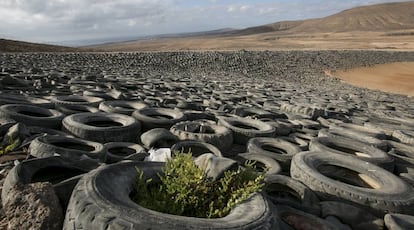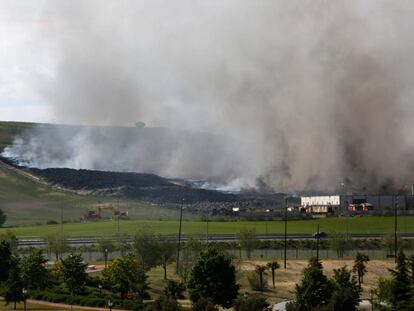Brussels puts another tire dump under the spotlight
European Commission demands explanations for the 200,000 tires in Fuerteventura

In a written inquiry about the illegal tire dump in Seseña, Toledo, dated 15 days before a fire broke out there last week, the European Commission also asked Spain about another pile of rubber – this time at the Zurita dump in Puerto de Rosario, on the island of Fuenteventura.
“According to the information at our disposal, the Zurita dump is a high fire risk due to exposure to high temperatures and strong winds,” the Commission observed in its letter.
At Zurita, which includes a waste treatment plant besides the dump proper, gulls gather to check out the spoils and three diggers rock perilously atop mountains of waste. There are 200,000 discarded tires here, but despite the European Commission’s concern and request for information, local authorities insist the tires are not a hazard.
We’re told there’s the odd fridge and a few chairs in there
Margarita Pérez, local resident
Zurita has an enormous depression in the ground covering 67,000m2 – called Cell 3 – which has been filled with thousands of tires. For a decade, dumping untreated tires in this way has been illegal due to a number of components that make them environmentally problematic.
In September 2014, the environmental wing of the Guardia Civil, the Seprona, warned Fuerteventura authorities that dumping tires at Zurita was illegal. And Brussels questions whether Zurita complies with European regulations aimed at preventing exactly the kind of fire that broke out in Seseña last week.
Local authorities insist they are dealing with the problem, and that the reason the tires are there is because European regulations allow for their use as a foundation for other urban waste.
Sign up for our newsletter
EL PAÍS English Edition has launched a weekly newsletter. Sign up today to receive a selection of our best stories in your inbox every Saturday morning. For full details about how to subscribe, click here.
The tires, they say, are being arranged on top of a waterproof sheet to prevent contaminating the ground. These is turn will be covered with half a meter of soil, on top of which the island’s other waste will be dumped.
According to the head of the Fuerteventura government, Marcial Morales, these measures guarantee that “there will be no contamination from the new waste. It will turn into an inert, innocuous mass with no environmental side effects.”
200 tons of untreated tires
The trouble is that there are still 200 tons of leftover tires that could not be used for this purpose, and which are scattered in piles across the plant. Authorities admit these tires are illegal, and have told the European Commission they will have them removed within the month.
They also dismiss Brussels’ fears of another fire, pointing out that there are far fewer tires in Zurita than in Seseña. There is, they say, high security at Zurita – 24-hour surveillance, security cameras and high fencing – preventing the risk of intruders while the chances of a fire starting through natural causes are remote.
Three kilometers from Zurita is La Mareta, a suburb of the island’s capital. According to the mayor of Puerto del Rosario, Nicolás Gutiérrez, “the houses are far enough away if anything was to happen.”
His confidence is shared by others in the vicinity, such as Margarita Pérez, 54, and her brother Marcial, 53. The possibility of the tires going up in flames and the smoke choking the neighborhood is not high on their list of concerns. They are much more worried about the streets getting paved and the new warehouses licensed.
It is also true that they have no idea what is inside Zurita. “We’re told there’s the odd fridge and a few chairs,” Margarita says.
English version by Heather Galloway.
Tu suscripción se está usando en otro dispositivo
¿Quieres añadir otro usuario a tu suscripción?
Si continúas leyendo en este dispositivo, no se podrá leer en el otro.
FlechaTu suscripción se está usando en otro dispositivo y solo puedes acceder a EL PAÍS desde un dispositivo a la vez.
Si quieres compartir tu cuenta, cambia tu suscripción a la modalidad Premium, así podrás añadir otro usuario. Cada uno accederá con su propia cuenta de email, lo que os permitirá personalizar vuestra experiencia en EL PAÍS.
¿Tienes una suscripción de empresa? Accede aquí para contratar más cuentas.
En el caso de no saber quién está usando tu cuenta, te recomendamos cambiar tu contraseña aquí.
Si decides continuar compartiendo tu cuenta, este mensaje se mostrará en tu dispositivo y en el de la otra persona que está usando tu cuenta de forma indefinida, afectando a tu experiencia de lectura. Puedes consultar aquí los términos y condiciones de la suscripción digital.
More information
Últimas noticias
From Andorra to Gibraltar, a black market for Ozempic exploits its success: ‘They’re the most sought-after products in the world’
From Hungary’s Orbán to Chile’s Kast: How Trump helps turbo charge the far right
Magnets in their heads: How some animals guide themselves using the Earth’s magnetic field
The brief rise and retreat of Generation Z in Mexico
Most viewed
- Why we lost the habit of sleeping in two segments and how that changed our sense of time
- Trump’s obsession with putting his name on everything is unprecedented in the United States
- Charles Dubouloz, mountaineering star, retires at 36 with a farewell tour inspired by Walter Bonatti
- Venezuela faces its most tense Christmas yet
- The Florida Keys tourist paradise is besieged by immigration agents: ‘We’ve never seen anything like this’










































